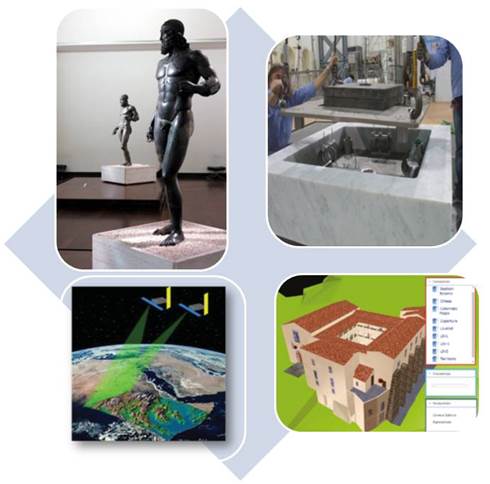Brought to you by the Disaster Risk Management Analytics and Solutions (D-RAS) KSB & the Culture, Heritage, and Sustainable Development KSB
Enhancing Resilience of Cultural Heritage Saving Unique Treasures, Contributing to Local Economies
Wednesday, December 2, 2015 || 12:30 - 2:00 pm || Room I 7-022
Description:
How do we enhance resilience of delicate cultural heritage assets that attract visitors to the cities we work with? This BBL will present some innovative and compelling solutions applied to heritage in urban areas prone to natural disasters. A team of experts from the Italian National Institute of Geophysics and Volcanology (INGV), University of Calabria, and Italian National Agency for New Technologies (ENEA) will give us the unique opportunity of learning about their groundbreaking solutions and their implications for local economies.
Solution 1: Anti-Seismic Basements. This solution is about a state-of-the-art device to reduce vulnerability of heritage artefacts to seismic hazards, designed to absorb vibrations and shocks. The cases of the Riace Bronzes and Michelangelo’s David will be presented. These statues are kept in highly seismic urban areas and are prime assets to attract visitors to the cities in which they are located.
Solution 2: Space Observation and 3D Web. An application of advanced monitoring of cultural heritage will be presented. Building on know-how developed for space observation, blended with 3D modelling, this solution is the result of a multiyear project called Massimo and aims at putting in place a monitoring system that integrates real time and remote sensing data (proximal, airborne, and satellites) with the objective of making heritage sites safer for visitors.
Chair:
Catalina Marulanda, Lead Urban Specialist and Acting Practice Manager, GSURR
Presenters:
Dr. Maria Fabrizia Buongiorno is Director of Technology Research and Head of Space Observation Infrastructure at the National Earthquake Center, Italian National Institute of Geophysics and Volcanology (INGV). Her research interests include environmental remote sensing and spectral analysis, using both in situ and space retrieved measurements, development of new technologies and sensors to investigate terrestrial surface and atmosphere, with particular regard to the volcanic areas, and unmanned airborne vehicles for volcanic and seismic emergencies. She has been coordinator of national and international research projects founded by the Italian Department of Civil Protection, Italian Space Agency, European Space Agency and European Commission, including the recent PON Massimo project.
Dr. Gerardo De Canio is Head of the Sustainable Innovation Technology Laboratory at the Italian National Agency for New Technologies (ENEA).
His research fields include earthquake protection of heritage assets, analysis of movable and semi-movable heritage assets, dynamic characterization and experimental verification of new technologies and materials for seismic protection of delicate instruments and control systems for strategic infrastructures and heritage, design of anti-seismic basements for high vulnerable statues, structural dynamics, shaking table tests, combined climatic and vibration tests, EMC tests, qualification of systems and components for industrial applications, railway transport, aerospace, and civil engineering.
Dr. Fawzi Doumaz is Senior Researcher and manager of the Cultural Heritage Laboratory at the National Earthquake Center of the Italian National Institute of Geophysics and Volcanology (INGV). His main research fields include software development in GIS environment for visualizing seismicity in real time, creation of hardware infrastructures for centralized management of geospatial data, design and WebGIS for interactive navigation and distribution of scientific data, mapping software for mobile devices to disseminate near real time synchronized information, synchronized multi-discplinari data acquisition and volcanological survey, geophysical data acquisition software in Antarctic environments. He is responsible for the development of the Database of Italian Volcanoes Prototype and of a web interface for an early warning alert for Stromboli volcano, called Paroxysm project.
Calendar » Enhancing Resilience of Cultural Heritage Saving Unique Treasures, Contributing to Local Economies
Enhancing Resilience of Cultural Heritage Saving Unique Treasures, Contributing to Local Economies
Brought to you by the Disaster Risk Management Analytics and Solutions (D-RAS) KSB &
the Culture, Heritage, and Sustainable Development KSB
Enhancing Resilience of Cultural Heritage
Saving Unique Treasures, Contributing to Local Economies
Wednesday, December 2, 2015 || 12:30 - 2:00 pm || Room I 7-022
Description:
How do we enhance resilience of delicate cultural heritage assets that attract visitors to the cities we work with? This BBL will present some innovative and compelling solutions applied to heritage in urban areas prone to natural disasters. A team of experts from the Italian National Institute of Geophysics and Volcanology (INGV), University of Calabria, and Italian National Agency for New Technologies (ENEA) will give us the unique opportunity of learning about their groundbreaking solutions and their implications for local economies.
Solution 1: Anti-Seismic Basements. This solution is about a state-of-the-art device to reduce vulnerability of heritage artefacts to seismic hazards, designed to absorb vibrations and shocks. The cases of the Riace Bronzes and Michelangelo’s David will be presented. These statues are kept in highly seismic urban areas and are prime assets to attract visitors to the cities in which they are located.
Solution 2: Space Observation and 3D Web. An application of advanced monitoring of cultural heritage will be presented. Building on know-how developed for space observation, blended with 3D modelling, this solution is the result of a multiyear project called Massimo and aims at putting in place a monitoring system that integrates real time and remote sensing data (proximal, airborne, and satellites) with the objective of making heritage sites safer for visitors.
Chair:
Catalina Marulanda, Lead Urban Specialist and Acting Practice Manager, GSURR
Presenters:
His research fields include earthquake protection of heritage assets, analysis of movable and semi-movable heritage assets, dynamic characterization and experimental verification of new technologies and materials for seismic protection of delicate instruments and control systems for strategic infrastructures and heritage, design of anti-seismic basements for high vulnerable statues, structural dynamics, shaking table tests, combined climatic and vibration tests, EMC tests, qualification of systems and components for industrial applications, railway transport, aerospace, and civil engineering.